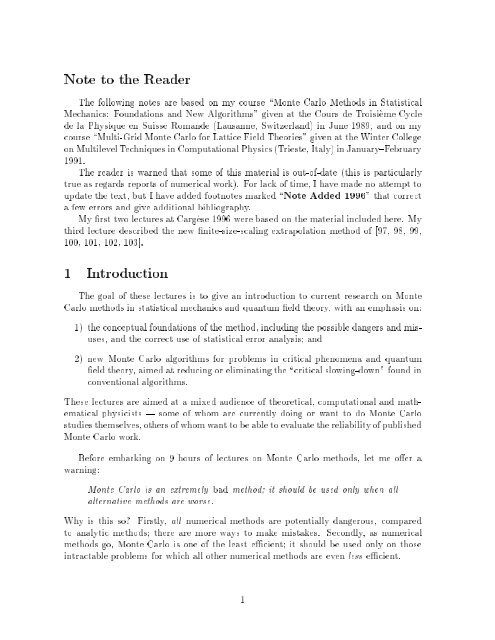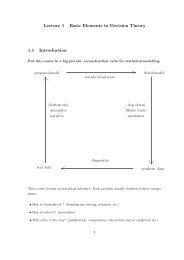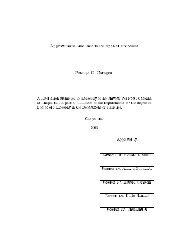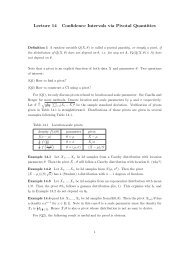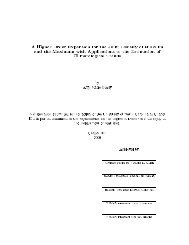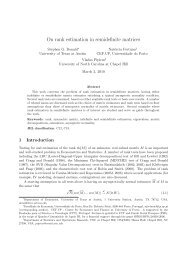Monte Carlo Methods in Statistical Mechanics: Foundations and ...
Monte Carlo Methods in Statistical Mechanics: Foundations and ...
Monte Carlo Methods in Statistical Mechanics: Foundations and ...
You also want an ePaper? Increase the reach of your titles
YUMPU automatically turns print PDFs into web optimized ePapers that Google loves.
Note tothe Reader<br />
The follow<strong>in</strong>g notes are based on my course \<strong>Monte</strong> <strong>Carlo</strong> <strong>Methods</strong> <strong>in</strong> <strong>Statistical</strong><br />
<strong>Mechanics</strong>: <strong>Foundations</strong> <strong>and</strong> New Algorithms" given at the Cours de Troisieme Cycle<br />
de laPhysique en Suisse Rom<strong>and</strong>e (Lausanne, Switzerl<strong>and</strong>) <strong>in</strong> June 1989, <strong>and</strong> onmy<br />
course \Multi-Grid <strong>Monte</strong> <strong>Carlo</strong> for Lattice Field Theories" given at the W<strong>in</strong>ter College<br />
on Multilevel Techniques <strong>in</strong> Computational Physics (Trieste, Italy) <strong>in</strong> January{February<br />
1991.<br />
The reader is warned that some ofthis material is out-of-date (this is particularly<br />
true as regards reports ofnumerical work). For lack oftime, I have made noattempt to<br />
update the text, but Ihave added footnotes marked \Note Added 1996" that correct<br />
a few errors <strong>and</strong> give additional bibliography.<br />
My rst two lectures at Cargese 1996 were based on the material <strong>in</strong>cluded here. My<br />
third lecture described the new nite-size-scal<strong>in</strong>g extrapolation method of [97, 98, 99,<br />
100, 101, 102, 103].<br />
1 Introduction<br />
The goal of these lectures is to givean<strong>in</strong>troduction to current research on <strong>Monte</strong><br />
<strong>Carlo</strong> methods <strong>in</strong> statistical mechanics <strong>and</strong> quantum eld theory, withanemphasis on:<br />
1) the conceptual foundations of the method, <strong>in</strong>clud<strong>in</strong>g the possible dangers <strong>and</strong> misuses,<br />
<strong>and</strong> the correct use of statistical error analysis <strong>and</strong><br />
2) new <strong>Monte</strong> <strong>Carlo</strong> algorithms for problems <strong>in</strong> critical phenomena <strong>and</strong>quantum<br />
eld theory, aimed at reduc<strong>in</strong>g or elim<strong>in</strong>at<strong>in</strong>gthe \critical slow<strong>in</strong>g-down" found <strong>in</strong><br />
conventional algorithms.<br />
These lectures are aimed at a mixed audience of theoretical, computational <strong>and</strong> mathematical<br />
physicists |someofwhom are currently do<strong>in</strong>g orwant todo<strong>Monte</strong> <strong>Carlo</strong><br />
studies themselves, others of whom wanttobeable toevaluatethereliabilityofpublished<br />
<strong>Monte</strong> <strong>Carlo</strong> work.<br />
Before embark<strong>in</strong>g on9hours of lectures on <strong>Monte</strong> <strong>Carlo</strong> methods, let me o er a<br />
warn<strong>in</strong>g:<br />
<strong>Monte</strong> <strong>Carlo</strong> is an extremely bad method it should be used only when all<br />
alternative methods are worse.<br />
Why isthis so? Firstly, all numerical methods are potentially dangerous, compared<br />
to analytic methods there are more ways to make mistakes. Secondly, asnumerical<br />
methods go, <strong>Monte</strong> <strong>Carlo</strong> is one ofthe least e cient it should be used only on those<br />
<strong>in</strong>tractable problems for which all other numerical methods are even less e cient.<br />
1


